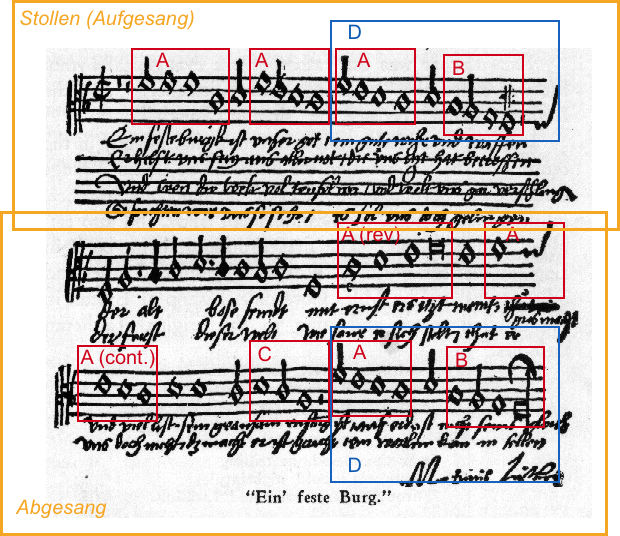Substantially, I say something only once, i.e. repeat little or nothing. (Arnold Schoenberg, Style and Idea, p. 102)
So, essentially my contribution was to introduce repetition into Western music as the main ingredient without any melody over it, without anything just repeated patterns, musical patterns. (Terry Riley, Interview with Gamall Awad and Ammon Haggerty for Rhythmos Magazine, October 1992)
Is repetition in music interesting and engrossing, or annoying and banal? Some people dislike minimalism (the Terry Riley variety) because it’s too repetitive; others like it because for them it produces a sense of calm and well-being, or some other state of consciousness that they’re seeking. Contemporary worship songs are often criticized for mindless repetition of lyrics and musical content, or defended for being so repetitive, or sometimes compared favorably with the repetition found in some of the Psalms. Excessive repetition of particular musical clichés is one of the marks of amateurish song writing and composition. Masterful use of repetition is one of the marks of great song writing and composition. On the other hand, Schoenberg did not endear himself to the general population by studiously avoiding repetition in his music, but there is something to be said for the creative freedom and “developing variation” for which Schoenberg strove.
From a performer’s perspective, understanding repetition in music is one of the keys to gaining a deeper understanding of the essence of the music you are performing. For example, my work at learning a contemporary composition for piano generally goes through several stages: 1) This is incomprehensible nonsense! I have no motivation to keep plowing through this stuff – the music isn’t worth it; 2) Oh, wait! There’s actually some thematic material here that somehow connects to the thematic material there, and it kind of makes sense; 3) I sort of like this part – it’s an interesting development of the main rhythmic motive and melodic progression; 4) This piece is growing on me – I actually like it (after repeated practice sessions)!
I believe (but would have a difficult time proving) that the best music contains repetition on multiple levels that is not always obvious on first hearing, or first performing. This can be true of the simplest folk song, or the most complex symphonic score. The most obvious repetitions are the patterns that either attract or repel us initially. In the case of popular music, the songs that disappear from charts quickly are probably the ones that only repeat obvious clichés; songs that remain popular over time probably have repetitions at other levels that aren’t as obvious at first, but which add to the overall interest of the song.
To illustrate this idea, here are some observations about repetition in one of the greatest Protestant hymn tunes ever written (if judged by its staying power, universal recognition, or use in other major works such as Mendelssohn’s Reformation Symphony).

(Original manuscript image from wikipedia.org; markings are mine)
Martin Luther followed the practice of German Meistersinger and Minnesinger by using Bar form in this hymn tune. The first part of the tune is comprised of a phrase that is repeated (the Aufgesang), and a second (usually longer) phrase not repeated (the Abgesang). Since this is a strophic hymn, the entire hymn tune is repeated with each new stanza. The manuscript above shows two stanzas: two lines of text per stanza in the Aufgesang, and one line of text per stanza in the Abgesang.
Within each stanza there are some interesting repetitions. The first (labeled A in red) takes the form of a descent of a fourth from the highest pitch (“F”) to the tenor or dominant pitch (“C”) in the Aufgesang. The second, also in the Aufgesang (labeled B in red), descends from “B♭” to the lower “F.” The Abgesang begins with an ascent from the lower “F” to the dominant “C,” followed by ornamental neighbor tones above and below the dominant “C” and a drop back to the lower “F.” This is followed by a retrograde (backwards) statement of A, an ascent of a fourth from the dominant “C” up to the highest note “F” (labeled A (rev) in red), another repetition of A (labeled in red), and another descent of a fourth from “D” to “A” (labeled C in red). The phrase containing both A and B at the end of the Aufgesang is then repeated at the end of the Abgesang (labeled D in blue).
The entire melody for Ein feste Burg is contained within the range of a single octave. The repetitive use of the descending (or sometimes ascending) fourth interval, which subdivides the octave into two parts (essentially the two major tetrachords which form a major scale), paired with the contrasting descent of a fourth from the 6th note of the (modern major) scale to the third note (“D” to “A” – labeled C in red) in the middle of the Abgesang, gives this melody unity without sounding like mindless repetition. Unity is also achieved by using the D unit at the ends of the Aufgesang and Abgesang.
Why has Ein feste Burg lasted for so long, and remained singable for almost 500 years? Perhaps there was something of lasting value to the art and craftsmanship of the Meistersinger.
Links:
Wikipedia article on Bar form.
Finale from Mendelssohn Symphony No. 5 “Reformation.”
Bach – Cantata BWV 80 – Ein feste Burg ist unser Gott.
Luther’s Hymn Melodies: Style and form for a Royal Priesthood, by James L. Brauer.
